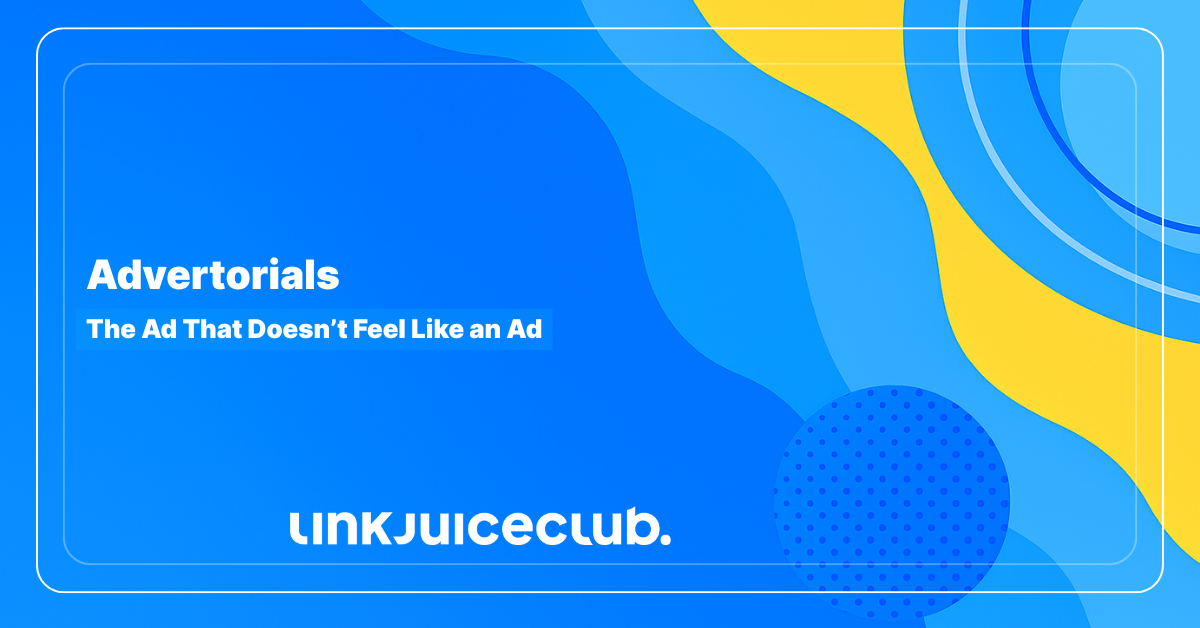
Advertorials: The Ad That Doesn’t Feel Like an Ad
Most ads interrupt. Advertorials fit in. They don’t shout “buy now!” — they tell a story worth reading, while quietly pointing the reader toward your brand.
Done right, an advertorial blends perfectly with its surroundings. It gives the reader useful information or an entertaining read, while naturally weaving in your product or service. That’s why they work — they inform, engage, and sell without triggering ad fatigue.
If you want to connect with your audience, build credibility, and get real results without looking pushy, advertorials are the play.

What Is an Advertorial?
An advertorial is a hybrid between editorial content and advertising. It’s written like a genuine article but carries a brand message. The magic is in making it feel like part of the publication — matching the tone, style, and value readers expect.
They live in magazines, newspapers, blogs, and news sites. Whether in print or digital, they succeed by blending in. Instead of breaking the flow like a banner ad, they ride along with it.
Why does this matter? Because readers don’t lower their guard. They stay engaged, they trust the content, and they absorb your message without feeling sold to.
The Core Traits of an Advertorial That Works
1. It Looks and Feels Like Editorial Content
The best advertorials don’t stand out as ads. They match the publication’s tone, layout, and style.
Example: A health magazine advertorial on “5 Ways to Boost Energy Naturally” should sound like any other wellness article — credible, well-researched, and informative — with your supplement appearing as one of the solutions.
2. It Gives the Reader Something Valuable
If the only value is “buy our thing,” you’ve already lost. A good advertorial teaches, entertains, or informs first.
Example: A tech company writing about “The Future of AI in Healthcare” offers readers insight into industry trends, while showing how their platform plays a role in that evolution. The value makes the brand memorable.
3. It’s Honest About Being Sponsored
Deception kills trust. The smartest brands are upfront — using labels like “Sponsored Content” or “Presented by [Brand]” without disrupting the reading flow.
Why? Because transparency builds credibility. Readers appreciate being told upfront what they’re looking at — and will trust your brand more for it.
Why Advertorials Are Marketing Gold
Enhanced Credibility
Advertorials borrow the trust of the publication they run in. When your message appears in a respected outlet, readers take it more seriously.
If your brand is featured in a major business magazine, the credibility boost is instant — because readers already trust the platform.
Higher Engagement
Readers skip blatant ads but stay for relevant stories. An eco-friendly home brand can run an advertorial in a sustainability magazine showing “10 Ways to Reduce Household Waste.”
The audience cares about the topic, so they read the entire piece — and leave with your brand tied to a positive solution.
Pinpoint Targeting
Pick the right publication, and you’re in front of exactly the people you want to reach.
A skincare brand partnering with a beauty magazine doesn’t have to fight for relevance — the audience is already interested in skincare.
Brand Awareness That Sticks
Instead of hammering your logo, you build a story people remember. The association between your brand and a valuable insight lasts far longer than a one-off display ad.
SEO and Traffic Wins
In the digital world, advertorials can link directly to your site. These aren’t random clicks — they’re visitors who already understand your offer.
Placed on credible, relevant sites, those links also strengthen your SEO through high-quality backlinks. That’s short-term traffic and long-term search gains in one move.
How to Create an Advertorial That Pulls Its Weight
Know Your Audience Inside Out
Skip this step and everything else falls apart. You need to know what your audience cares about, where they get their information, and how they like it delivered.
If you’re a fitness brand targeting busy professionals, write about 15-minute workouts they can do before work. The more specific, the better.
Lead With Story, Not Sales Pitch
An advertorial should feel like a conversation, not a commercial. Start with the reader’s problem or curiosity, then show how your brand fits into the solution.
A travel company could write about a “Hidden Gem Destination You’ve Never Heard Of” and weave in how their booking platform makes it easy to get there.
Use Visuals That Add Punch
Great visuals keep readers hooked. Use photos, infographics, or videos that match the tone of the piece.
A food brand can show step-by-step images of a recipe, making the content instantly more engaging and shareable.
Close With a Natural CTA
The call to action should feel like the logical next step. If you’ve given value, the CTA becomes an invitation, not a demand.
Example: “See how we can help you plan your perfect trip — explore our free destination guide.”
Advertorials vs. Native Advertising
Both formats blend into their surroundings, but advertorials go deeper. They’re longer, more detailed, and work best when you need to educate or persuade before prompting action.
Native ads, like sponsored social posts, are shorter and built for quick impact. They grab attention fast but don’t offer the same space for storytelling.
Transparency Isn’t Optional — It’s the Foundation
Trust Comes First
Trying to hide that content is sponsored is the fastest way to lose credibility. Readers feel cheated, and the brand’s reputation takes the hit.
Follow the Law
In most markets, clear labeling is a legal requirement. The UK’s ASA, for example, demands terms like “Advertisement” or “Sponsored” appear prominently. Skip it, and you risk fines and bad press.
Disclose Without Killing Engagement
Make it clear but seamless. “Presented by [Brand]” at the top of an article can meet requirements while keeping the focus on the content.
Final Word: The Ad That Builds Relationships
Advertorials win because they respect the reader. They give value first, sell second, and leave the audience with a better impression than when they arrived.
Done right, they’re not just a campaign — they’re a trust-building engine that drives awareness, engagement, and sales long after publication.
If you want your brand to be remembered for the right reasons, start using advertorials that educate, inspire, and deliver.





